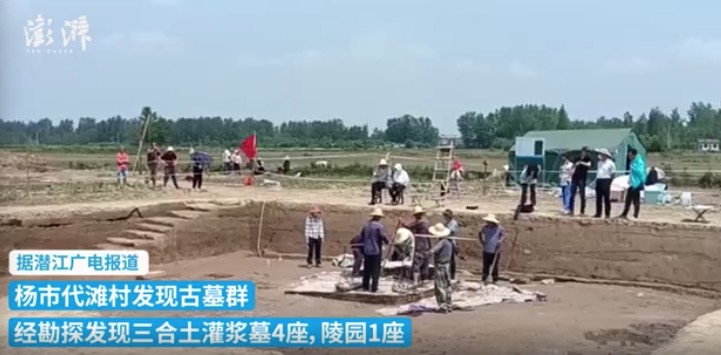
The screenshot of The Paper
Ancient tombs from the Ming Dynasty (1368-1644) were discovered in the village of Daitan, in Qianjiang city of Central China's Hubei Province, local media outlet Qianjiang Radio & Television Station reported on Sunday. The tombs are now in the middle of a rescue excavation and are still unidentified so far.
The archeological site includes four grouted tombs, and one cemetery surrounding the tombs. The librarian from Hubei Provincial Institute of Cultural Relics and Archaeology explained that the tombs are from the Ming dynasty period. The first coffin has been opened and the remains inside can be directly investigated.
With the approval of the State Administration of Cultural Heritage, a joint team, consisting of the Hubei Provincial Institute of Cultural Relics and Archaeology and Qianjiang Museum, will conduct a rescue excavation of the tomb. The total excavated area of the tomb complex so far reached 400 square meters.
As no epitaph has been found, the occupants of the tombs remain unidentified.
Archaeological experts said that physical historical materials and the remains will allow the study of the burial customs and design in Qianjiang during that period. In addition, the archaeological team can also learn about the level of ancient technology and social and economic life at that time in the same location.
Wen Li, an official with the Hubei Provincial Institute of Cultural Relics and Archaeology, told the media that after the burial objects are cleaned up, they will be further restored and displayed in museums for the public to visit.
Hubei has been a major province in the discovery and maintenance of cultural relics, with museums holding more than 1.57 million cultural relics.
The tomb of the Marquis Yi of Zeng, excavated in 1978 in Leigu Dun, suburb of Suizhou city, is the tomb of the king of Zeng in the early Warring States Period (475BC-221BC). On April 27, 2018, the top leaders of China and India jointly visited an exhibition of fine cultural relics at the Hubei Provincial Museum, making Hubei become an even more popular place for tourists and archaeologists.
Global Times




